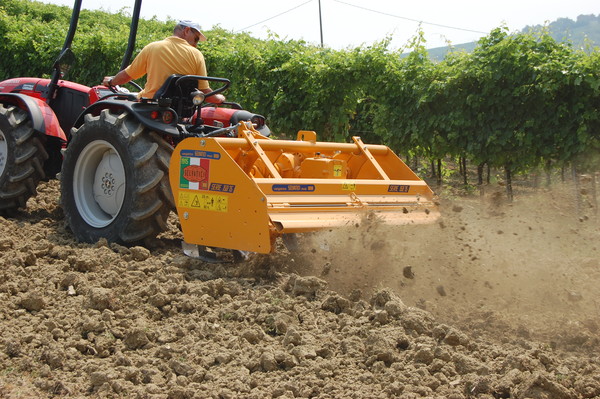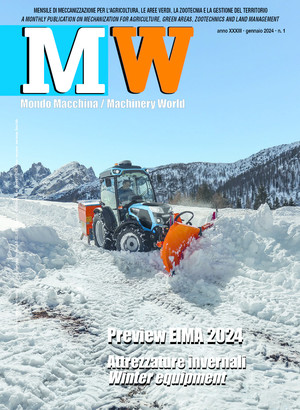
Spading machines, the ideal tool for difficult terrain
Thanks to the formation of medium-sized clods and especially for the absence of hardpan, the spading machine works best even on soils that are wet, or even saturated with water, or conversely on very dry and compact soils. The manufacturers of this equipment – for which Italy has a particular tradition - offer a very wide range of models for every need
The options for the traditional preparation of seedbeds offer basically three possibilities, namely the classic combination plow-harrow, hoeing or spading. Especially forhorticulture, floriculture and nurseries, where typically several cultivation cycles per year are performed, there are two main objectives to attain: a high refinement of the soil and the absence of hardpan. In the case of particularly abundant rain, in open field crops this could create radical asphyxia areas due to water saturation in the soil gaps.
Due to the particular working methods, both the plow and the tiller produce a typical plow sole on the bottom of the processed layer. This involves root asphyxia and further problems due to an increased difficulty in penetrating deep to the roots and an increase energy expenditure to return the soil to the correct structure for subsequent crops.
This does not happen for spading, because the specific ways in which the working parts operate avoid the creation of the illustrated problems. The spades are moved by a flat articulated wishbone structure, where the horizontal bridge is formed by the supporting frame that connects to the three-point linkage, while each spade is located at the end of a connecting rod powered by the tractor’s PTO. In practice, each individual working part faithfully simulates the manual spading action, performing an oblique cut at a specific depth of a “slice” of soil, which is then torn, raised and thrown in the direction opposite to how it is advancing.
To increase the degree of disintegration of the soil, there is almost always a screen in sturdy sheet metal with adjustable inclination, which is hit by the loose soil, further breaking the clods that have been created, or alternatively a grid of varying shapes. Both accessories are also intended to coarsely level the surface of the processed layer.
In practice, besides the absence of hardpan, the main advantage of the spading machine is precisely to enable the tilling and draining of land prone to asphyxia, by performing this work during periods when it would be impossible to enter the field with any other tool. This involves many considerable operating advantages, especially in those areas where the characteristics of agricultural soil and the micro-climate make working the soil in spring crucial.
Processing parameters
The optimization of the degree of soil mulching is not an immediate operation: in addition to the obvious characteristics of the soil (primarily texture, humidity, degree of compaction, amount of surface crop residues), we must carefully consider the two main operating parameters, namely the forward speed of the machine and that of the rotors. The values of both are adjustable within relatively wide limits: in short, a limited forward speed and a high rotation of the working parts will result in a high comminution, such as not to require in most cases a further refining step, at least for planting seeds that are not particularly small. Conversely, a higher forward speed, combined with a low spades rotation, will produce coarse clods, preceding a further step for the final settlement of the seedbed. The power absorption (which is exclusively supplied to the PTO, given that to operate, the spading machine requires virtually no traction force) is essentially based on the amount of soil worked over time, in addition to its conditions when it is tilled. The range starts at a few Hp for the models less than 1 m wide with depths of no more than 15-17 cm, operable also with the motocultivator and suitable for periodic work in gardens and in the inter-row of specialized crops. The range then reaches 250 Hp and more for the heavy spading machines for the open field, which can reach weights of 4000 kg.
Indicatively, the typical forward speeds vary from less than 1 to 3.5 km/h, while speeds of the rotors range from less than 100 to more than 200 revolutions/min. For this reason, almost all spading machines are equipped with a simple (but sturdy) 2-4-speed manual gearbox, which allows you to adjust the rotation within rather wide limits.
The working depth is based on the shape and size of spades: normally, these working parts are trapezoidal, with the lower short side, which penetrates the soil, more or less narrow than the upper one. In addition to the width, the length of the spade can also vary, with the longer ones being recommended for light soils, which are easier to till. From this point of view, we can distinguish two classes of spading machines: “light” ones for working depths up to about 25 cm, and “heavy” ones, which for obvious reasons are much more sturdy than the first, which can reach and sometimes exceed 45-50 cm of tilled layer. The depth adjustment is usually achieved using a pair of slides that crawl on the soil surface or, alternatively, with hollow steel wheels.
The power required for the processing is significant: because of the limited forward speed, to ensure a satisfactory working capacity it is necessary to work with spading machines of significant working width (even up to 4 m). The use of powerful tractors (which are therefore heavy) is also justified by the need to ensure an appropriate balance of loads during transport, since the spading machine is rather heavy (to ensure the necessary operating sturdiness) and attached to the three-point linkage. For work on specialized crops, there are models with bi-lateral translation, in order to operate conveniently both in the inter-row that in under-row.
The bivanga
Introduced back in 1987 by Selvatici of S. Lazzaro di Savena (BO), as the name suggests, the bivanga is a spading machine with double working parts. The additional spade improves the crushing of the soil, and during the ascending phase of the movement exerts a vigorous rotational effect to bury deep the residue of previous crops (stalks, stubble, shrubs, leaves, etc.). In favourable conditions, it prepares the ground for planting in a single pass. The pairs of spades can be positioned in six different combinations, so as to vary the working depth, or to optimize the degree of comminution of the soil. A bivanga can be combined with tools designed for the convex shaping of soil, a very important operation especially in horticulture and floriculture to facilitate the outflow of excess water.
Combined operations
Many of spading machine models are equipped with a rear power attachment, for combined coupling with other equipment: for example, with a rotary harrow, for preparing the seed bed in one step, or even with a seed drill (and possibly a fertilizer spreader), to plant the seeds at the same time.
Celli of Forlì proposes an interesting solution, offering the combination of the spading machine with the subsoiler for deep work to be carried out with its high work capacity models. In practice, the soil is tilled by the first tool for the first 40 cm of depth, while the subsoiler slices it for the 20 cm below, effectively increasing the aeration and the drainage capacity of the soil. Moreover, having to slice a thinner layer of soil, the tractive effort necessary for the subsoiler is greatly reduced compared to the traditional implementation of this operation. This benefits the coupled tractor, whose power can be fully exploited, both at the PTO and in terms of traction for forward speed.
The materials
The spading machine is typically a very sturdy machine, with powerful mechanical components in constant motion. For this reason, in order to ensure the appropriate levels of machine reliability and durability, especially for the more performing models, very thorough lubrication is required, for both the speed gears and the various crank mechanisms, achieved with high performance oils and dedicated grease types. Moreover, often the upper joints are equipped with bearings and special seals, suitable to support the heavy loads that develop. Because the hard soil is processed with working parts operated thanks to a rotational movement that comes exclusively from the PTO, the connecting cardan shaft must necessarily be heavy duty, accompanied by a load protection device, typically an adjustable multiple disc clutch.
To better withstand the intense wear, the spades are made with special high-performance steel, and are subject to appropriate thermal treatments to increase their surface hardness.
Tradition
The spading machine is a device that can undoubtedly boast an historical Italian market supremacy.
These are manufacturers that export the majority of the machines they produce to many European and non-European countries, being accustomed to compete effectively in difficult markets by providing a product that is specifically second to none.








